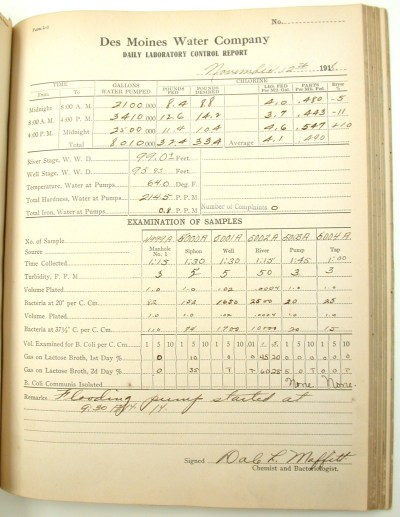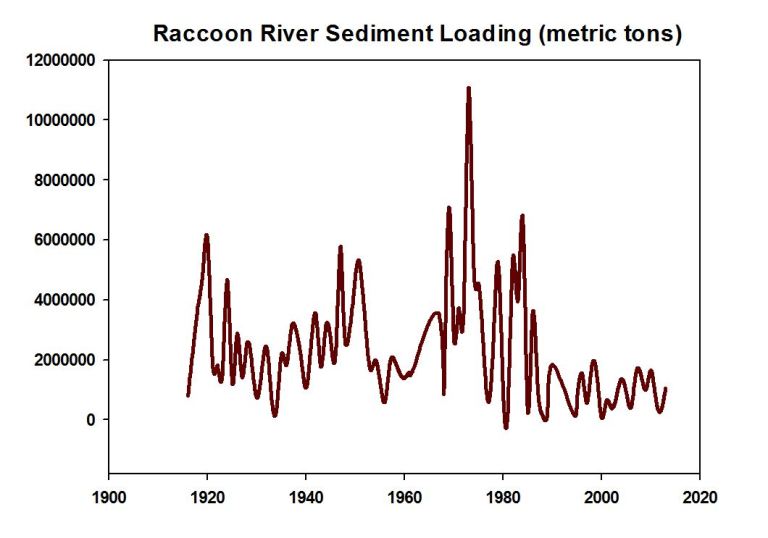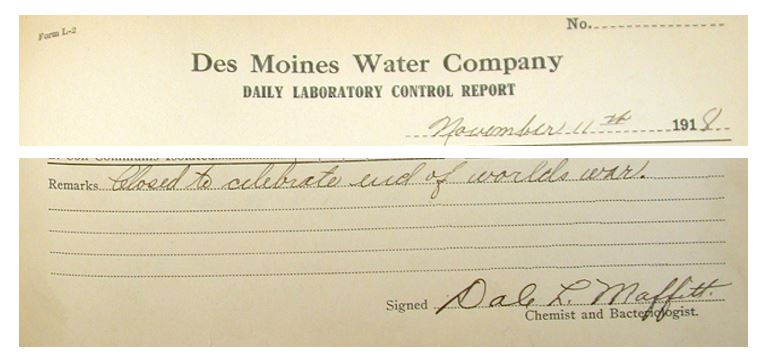Over the past 16 years, I’ve had access to an embarrassment of riches when it comes to water quality data. For example, when I worked at Des Moines Water Works (DMWW), I came upon a closet of old data logs dating back to 1916 in the musty basement of the Fleur Drive filter plant. This data included turbidity (clarity) measurements of the Raccoon River, meticulously recorded on a near daily basis initially by a guy named Dale Maffitt and by numerous others afterward.

Thinking that turbidity data could be a proxy for sediment levels transported by the river, I looked into how the early measurements were made and whether these could be compared to lab data generated a century later. As it turns out, turbidity was first quantified using something called a Jackson Candle Turbidimeter. A meter-long glass cylinder was housed within a brass tube to exclude external light. A candle illuminated the glass tube through a cross-shaped opening from below; water was poured into the tube until the cross disappeared, a process similar to taking Secchi-depth measurements in lakes. (The candle was eventually replaced by an electric light, but the method remained the same.) Modern turbidity measurements are made with a device called a Scattering Turbidimeter which uses sophisticated light sources and other optics. But to relate the historical turbidity to modern measurements, I needed a Jackson Turbidimeter.
It turned out there was one in the University of Iowa Water Treatment Plant. I was able to get that over to Des Moines and measure modern-day Raccoon River samples with both the old device and the modern equipment, while at the same time relating those measurements to suspended sediment data generated from the same river samples. In doing this I was able to transform a century’s-worth of turbidity data to sediment levels transported by the Raccoon River.

I went into the analysis expecting river sediment transport to have steadily increased since 1916. The data ended up saying something else. There was a tremendous improvement (decline) in Raccoon River suspended sediment after 1985. Despite some extremely wet years since then, levels have consistently stayed far below the worst conditions that were observed in the 1970s. Keith Schilling and I submitted a manuscript on this study to the Journal of Environmental Quality that was accepted for publication (1).
What happened to cause the improvement? Well, the 1985 Farm Bill happened. The legislation “required farmers to adopt various conservation practices in order to receive government payments, in an effort to improve consistency among policy objectives while reducing soil erosion” (2), if they were growing crops on “Highly Erodible Land” (HEL). HEL is found on about 8 million Iowa acres (1/3 of our cropland). This almost immediately improved water quality, and many farmers have recognized this. This testimonial from an Adair County farmer perhaps said it best:
“It was a requirement that on highly erodible soils that we establish no-till. I didn’t think much of no-till at all. I thought it was the biggest joke. From what I saw, it was pretty much a complete failure.” But then he tried it on his farm, and was amazed at what the soil tests showed. “The light went on as we watched our soil tests and the amount of organic matter went up, 2 to 3% up to 7% in 25 years.”
Organic matter helps build soil structure and prevent erosion, among other benefits. Other research from Iowa State University and USDA has shown conservation compliance worked (2,3), as soil erosion was reduced 40% between 1982 and 1997 (3).
Conservation compliance in the 1985 law was revolutionary because it linked private benefits (farm program payments) to social benefits (reduced erosion and improved water quality). Since the 1930s, the American taxpayer has paid about $300 billion to farmers for farm conservation (2009 dollars) (5), about $700 for every person that has ever lived in this country since that time. The 1985 law built expectations and accountability into our conservation programs, at least within the context of soil erosion. It’s not perfect (enforcement is a problem, for example), but positive outcomes definitely resulted.
So this brings me to a question. With attention now on nitrogen pollution, why don’t we revisit the conservation compliance idea? Policies at both the federal and state levels provide public money (cost share) to entice farmers into adoption of various practices and strategies designed to reduce nitrate-nitrogen in our streams. Like Conservation Compliance, adoption is voluntary. Unlike Conservation Compliance, however, failure to adopt results in no real pain for the farmer.

Unlike soil erosion practices, most nitrate-reduction practices provide little benefit to the farmer’s bottom line, nor do they enhance the value of the property, at least not much. There are exceptions, most notably cover crops, which can improve both. Public cost share on conservation practices can range from 40 to 90 percent depending on the program and the practice, but almost always some amount of farmer investment is required.
The rhetoric surrounding policies associated with nitrogen loss is notable. If you’re like me, you’ve probably heard for years nuggets like “every farm is different”, “one size does not fit all” and so on. There may be a thread of truth in some of the statements, but in my estimation, there is far more similarity between Iowa farms when it comes to fertilization than there is for soil erosion. These sorts of statements reflect dogmatic views and ignore the real and quantifiable successes that resulted from the conservation title in the 1985 Farm Bill.
There’s some other differences between 1985 and now. In 1985, deficiency payments were the main form of financial assistance to farmers. These payments were based on the difference between actual market prices and a “target price”, if the latter was greater than the former. Failure to adopt conservation (Conservation Compliance) was a big risk for the farmer—exclusion from deficiency payments could mean the difference between solvency and bankruptcy when prices swung low.
Deficiency payments had the effect of controlling the supply of grain on the market. This market stabilization was removed in the 1996 Farm Bill, about the time international markets began opening up with NAFTA and other agreements. This resulted in the market getting flooded with commodity grain and prices crashed, resulting in emergency payments to farmers. Emergency payments morphed into direct payments based on historical farm crop yields and farmed acreage.
Now the main commodity program is insurance, for weather, price and revenue. The taxpayer contributes more to insurance than to conservation programs. Conservation compliance still exists, i.e., availability to public support is still dependent upon adoption and maintenance of preventative soil erosion practices. But it’s still Katy Bar the Door when it comes to nitrogen. Statewide nitrate loads have increased more than 70% since 1999 as farm policies have abandoned control of supply and instead focused on expanded international trade and incentivized Max Acres. And it’s not just us. Countries that incentivize and indemnify production in such ways are also countries most likely to suffer from nutrient pollution.

I’d like to finish this with a few words about Dale Maffitt. That name is associated now with the cleanest constructed lake in Iowa. Maffitt was the chief chemist in the DMWW laboratory in 1916 and eventually became General Manager of the utility. It was really quite a feeling opening up those data logs and seeing his name and handwriting from an entire century earlier. He kept his lab books the way I was taught to (but never really did), meticulous and neat. Surely he could not have imagined his work being used in this context 103 years later. In working on these issues, many times we feel that our efforts are futile—the problems are so big and seemingly unsolvable. Maffitt’s lab entry for November 11, 1918, puts our problems into some perspective.

- Jones, C.S. and Schilling, K.E., 2011. From agricultural intensification to conservation: sediment transport in the Raccoon River, Iowa, 1916–2009. Journal of environmental quality, 40(6), pp.1911-1923.
- https://www.ers.usda.gov/amber-waves/2004/june/have-conservation-compliance-incentives-reduced-soil-erosion/
- Arbuckle, J.G., 2013. Farmer support for extending Conservation Compliance beyond soil erosion: Evidence from Iowa. Journal of Soil and Water Conservation, 68(2), pp.99-109.
- Uri, N.D., 1998. The role of public policy in the use of conservation tillage in the USA. Science of the total environment, 216(1-2), pp.89-102.
- Villarini, G., Schilling, K.E. and Jones, C.S., 2016. Assessing the relation of USDA conservation expenditures to suspended sediment reductions in an Iowa watershed. Journal of environmental management, 180, pp.375-383.